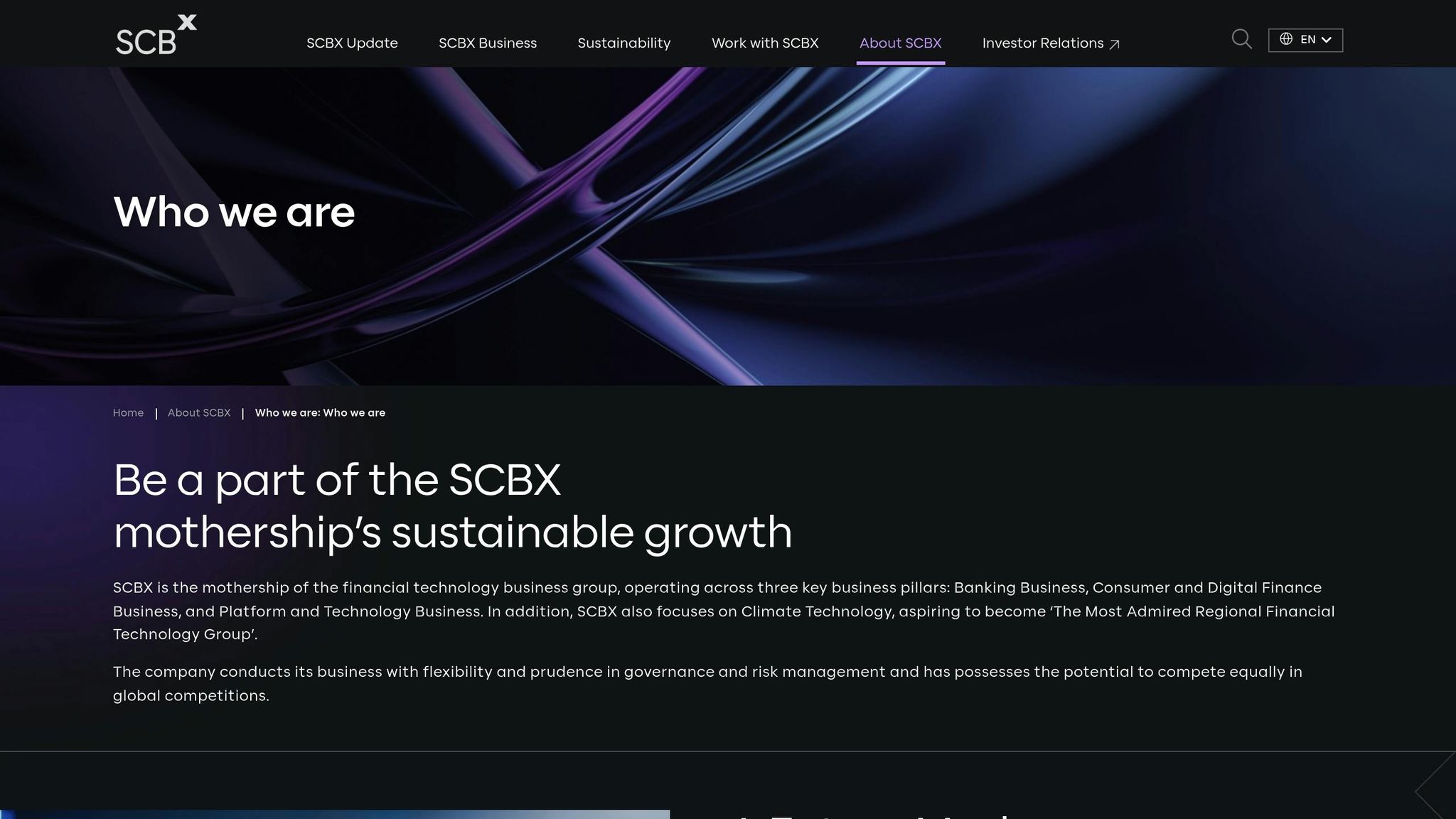The partnership between SCBX, Siam Commercial Bank‘s innovation arm, and Hashed, a South Korean Web3 venture capital firm, showcases how organizations can collaborate to develop blockchain solutions for financial services. By combining SCBX’s financial expertise with Hashed’s Web3 knowledge, they are working on practical applications like digital asset infrastructure, DeFi protocols, and blockchain-based payments.
Key takeaways:
- Collaboration Framework: Built on a formal Memorandum of Understanding (MOU) and supported by Hashed’s ShardLab research hub.
- Focus Areas: Integrating blockchain into SCBX’s ecosystem while addressing regulatory and operational challenges.
- Methods: Joint funding, research, and hosting Web3 events in Southeast Asia to advance the ecosystem.
- Outcomes: Early progress in merging blockchain with finance, though specific results remain under wraps.
For venture capital firms, this partnership highlights the importance of pairing financial expertise with blockchain capabilities, prioritizing practical solutions, and committing to long-term collaborative research.
Use Cases for Web3 in Banking and Finance at Future Blockchain Summit

How SCBX and Hashed Structure Their Collaboration

SCBX and Hashed have established a formal partnership that combines structured agreements with hands-on execution.
Building the Partnership Framework
At the heart of their collaboration is a Memorandum of Understanding (MOU), which marks the beginning of their joint efforts to explore Web3 technologies within SCBX’s ecosystem [2][3][4]. This partnership is anchored by ShardLab, Hashed’s research hub, which drives technology testing and new initiatives [2][3][4][6]. Together, SCBX and Hashed have created a jointly funded R&D model, pooling resources to integrate blockchain technology into SCBX’s services [2][4][5]. Overseeing this collaboration is Hojin Kim, Chief Strategy Officer at Hashed’s startup studio UNOPND, who ensures both organizations remain aligned in their objectives [1][6]. This framework sets the stage for focused and effective research.
Main Research Areas
The collaboration zeroes in on applying Web3 technologies to improve SCBX’s business operations. With ShardLab’s expertise, the team focuses on identifying blockchain solutions that can be smoothly incorporated into SCBX’s existing ecosystem. By targeting these specific areas, the partnership ensures their R&D efforts remain practical and results-driven.
R&D Methods and Tools
In addition to research, SCBX and Hashed organize specialized Web3 conferences and networking events across Thailand and Southeast Asia [2][4]. These events not only nurture technical talent but also contribute to the broader development of the Web3 ecosystem in the region.
Results and Real-World Applications
The collaboration between SCBX and Hashed has paved the way for exploring how Web3 can merge with traditional financial systems. This partnership has steered both organizations toward practical improvements in financial processes. Here’s a closer look at what their joint efforts have achieved so far.
Key Outcomes of the Collaboration
SCBX and Hashed have made strides in integrating decentralized technologies into established financial frameworks. While specific data remains under wraps, the initiative has focused on testing these integrations with an emphasis on performance, security, and regulatory compliance. These efforts are setting the stage for future advancements in the financial sector.
Applications for Businesses and Consumers
The research delves into how Web3 can benefit both businesses and individuals. Areas like transaction processing and digital identity management have been explored to enhance efficiency, strengthen security, and empower users with greater control over their data. These findings will guide upcoming experiments and developments.
Progress Indicators
Though detailed performance metrics haven’t been released, the ongoing collaboration and dedication to innovation suggest meaningful progress. This solid foundation hints at promising evaluations and breakthroughs in the near future.
sbb-itb-c5fef17
Challenges and Lessons from Web3 R&D
The collaboration between SCBX and Hashed highlights the potential of joint R&D efforts in the Web3 space. Yet, there’s a noticeable lack of detailed documentation about the specific challenges they faced and the lessons they learned. This stands out, especially when compared to the more comprehensive operational insights shared in other parts of this analysis.
Across the industry, common challenges like regulatory uncertainties, integrating complex systems, and educating users are frequently discussed. However, there’s no concrete evidence to show whether SCBX and Hashed formally tackled these issues or developed specific solutions. This lack of clarity points to a broader need for more transparent and detailed reporting in future Web3 R&D collaborations.
Impact on Web3 Venture Capital
The SCBX-Hashed partnership highlights how strategic R&D collaborations can serve as a model for venture capital investments in the Web3 space. It offers actionable insights for firms navigating the challenges and opportunities in this rapidly evolving landscape.
Guidance for Venture Capital Firms
This partnership underscores the importance of blending traditional financial expertise with in-depth blockchain knowledge to drive market adoption. Venture capital firms can benefit from forming hybrid partnerships that address the technical, regulatory, and market hurdles often encountered in Web3.
For venture capitalists, this suggests that collaborative strategies may yield better results than going it alone. Firms focusing on areas like AI-Web3 integration, advanced cryptographic solutions, and decentralized infrastructure can gain a competitive edge by partnering with organizations that bring complementary skills in finance or specific technical areas.
The SCBX-Hashed collaboration also highlights the value of long-term R&D commitments. Unlike short-term investments, sustained joint research efforts foster meaningful advancements in areas like digital finance and over-the-counter (OTC) markets.
Connection to Bestla VC‘s Focus Areas

These lessons align closely with Bestla VC’s approach. The SCBX-Hashed model resonates with Bestla VC’s focus on digital finance and the intersection of AI and Web3, emphasizing the importance of early-stage support that extends beyond financial backing to include technical and regulatory expertise.
The partnership’s emphasis on early-stage project support offers a roadmap for venture capital firms looking to provide more than just capital. By leveraging Bestla VC’s strengths in advanced cryptography and decentralized systems, alongside strategic partnerships, the firm can deliver comprehensive support, including market access, technical know-how, and regulatory navigation.
Additionally, Bestla VC’s commitment to advancing institutional and enterprise crypto adoption aligns with the SCBX-Hashed approach of bridging traditional finance with Web3 innovation. This kind of collaboration could help accelerate adoption among enterprise clients and institutional players.
Practical Recommendations
Here are some actionable steps for venture capital firms aiming to replicate the success of the SCBX-Hashed partnership:
- Seek complementary partners: Pair crypto-native firms with traditional financial institutions or match blockchain experts with organizations skilled in regulatory compliance to create well-rounded partnerships.
- Define governance structures early: Establish clear frameworks for joint R&D efforts, including transparent reporting mechanisms and measurable success metrics, to avoid ambiguity and ensure accountability.
- Commit resources for the long term: Allocate funding and effort to sustained research rather than expecting quick returns. Long-term R&D investments in both talent and technology are essential for meaningful innovation.
- Prioritize practical applications: Focus on R&D projects that address real-world challenges in digital finance, OTC trading, or consumer-facing solutions, ensuring a clear path to market adoption.
- Integrate regulatory compliance: Make legal and compliance expertise a core part of any collaboration. As Web3 regulations continue to evolve, this proactive approach ensures innovative solutions can successfully reach the market without unnecessary delays.
Conclusion: Main Lessons from SCBX and Hashed
The SCBX-Hashed partnership highlights how Web3 research and development thrives on collaboration between organizations with complementary strengths. By merging traditional financial expertise with advanced blockchain knowledge, they’ve crafted a model for how venture capital firms can effectively navigate the complexities of the Web3 landscape.
Long-term, hybrid partnerships are essential for overcoming both technical and market hurdles. SCBX’s established financial infrastructure, paired with Hashed’s crypto expertise, has allowed them to tackle challenges that neither could have addressed independently. Their sustained research efforts have also laid the groundwork for advancing core technologies over time.
Focusing on practical, market-ready solutions ensures innovations deliver measurable results. Their joint R&D prioritizes applications that encourage real-world adoption rather than getting stuck in theoretical pursuits. Coupled with proactive regulatory compliance, this approach helps ensure that innovative products reach the market without unnecessary delays.
The SCBX-Hashed collaboration offers a guide for venture capital firms looking to add value beyond just financial investment. By providing technical expertise, regulatory insights, and access to markets, strategic partnerships can offer resources that often outweigh the importance of funding alone.
Additionally, their approach underscores that regulatory compliance should be embedded from the start, not treated as an afterthought. This proactive stance on compliance sets the tone for how institutional players can adopt Web3 technologies responsibly and effectively.
FAQs
What challenges do SCBX and Hashed encounter when integrating Web3 technologies with traditional financial systems?
SCBX and Hashed encounter a range of challenges when attempting to integrate Web3 technologies with established financial systems. A key obstacle lies in managing the intricate and ever-changing regulations tied to blockchain and cryptocurrencies. These rules differ significantly from one region to another, making compliance a tricky and resource-intensive process.
Another pressing concern is the fragmented nature of the Web3 ecosystem, which hinders smooth interoperability with traditional financial frameworks. Bridging this gap demands substantial investment in research and development to design solutions that not only connect these systems but also prioritize scalability and security.
How does the SCBX and Hashed partnership impact the development of Web3 in Southeast Asia?
The partnership between SCBX and Hashed is making waves in the Web3 ecosystem across Southeast Asia. By merging SCBX’s strong foothold in Thailand’s financial industry with Hashed’s expertise in decentralized technologies, this collaboration is pushing forward the adoption of blockchain and driving cutting-edge research and development.
This alliance is doing more than just promoting innovation – it’s positioning the region as a key player in the Web3 landscape. The partnership opens doors for businesses and developers, paving the way for advancements in decentralized finance and infrastructure that could redefine the future of the industry in Southeast Asia.
What are the key Web3 innovations SCBX and Hashed are exploring in financial services, and how could these benefit businesses and consumers?
SCBX and Hashed are teaming up to build Web3 solutions that could reshape Thailand’s financial landscape. By tapping into blockchain and decentralized finance (DeFi) technologies, their collaboration aims to boost transparency, security, and efficiency in financial transactions. These improvements may help cut costs while making financial services more accessible for both businesses and everyday users.
A key area of focus is the development of decentralized systems for cross-border payments and digital asset management. These systems could simplify international transactions, broaden financial access, and create trustless financial services, offering meaningful benefits to a diverse group within the financial sector.


